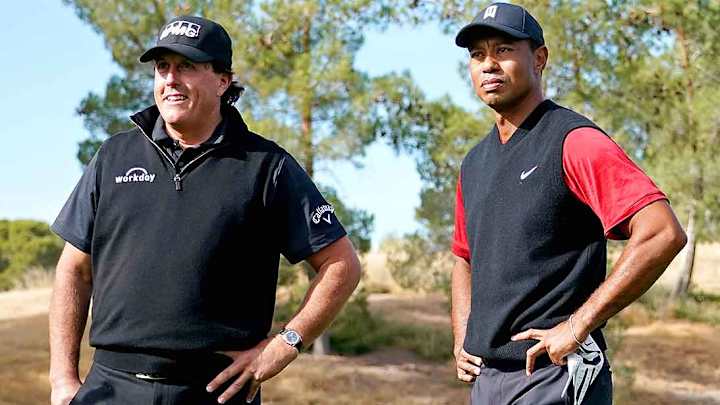PGA Tour Should Remember Its Roots and Reject Players' Idea of Limited-Field Events

ATLANTA — Honey, I shrunk the tour.
Correction. Honey, I shrunk all of professional golf.
What’s happening with LIV Golf, where every event is meant to be a big-deal cash extravaganza for “superstars” such as Wade Ormsby and Pat Perez, and a rumor that the PGA Tour may consider creating its own “super tour” within the tour is a threat to the continued existence of professional golf as we know it.
Meritocracy isn’t dead at LIV Golf, it was never born. The heroes who made it to that exhibition tour got there by invitation only. They were anointed.
Meritocracy is the PGA Tour’s greatest asset. Every player earns what he gets. Now maybe every player should get more, sure, but they play on a mostly level playing field.*
(*Disclaimer: OK, not here this week at the Tour Championship, where the field is handicapped like the B Flight at Bushwood instead of being a normal event where the guy who hits the fewest shots wins. The tour’s Head Start Program works like this: Scottie Scheffler amassed the most points all season, so he will start at 10 under par at East Lake Golf Club; second-ranked Patrick Cantlay starts at 8 under; third-ranked Xander Schauffele at 6 under; and so on down to the bottom of the 29-man field, where the lower players tee it up Thursday at even par, 10 shots back before they’ve hit a ball. It feels un-American and worse, it goes against the bedrock principles of the PGA Tour.)
The PGA Tour has always favored the rank and file because they’re the majority, but the vise grip of the tour’s rank and file began to fade in the ‘90s with the arrival of Tiger Woods, a superstar who wasn’t just bigger than golf, he was bigger than all sports. He has directly and indirectly affected the way the PGA Tour is presented. For two decades, Tiger and Phil Mickelson were the PGA Tour’s dynamic duo.

Remember when the new FedEx Cup series was born and they learned the $10 million bonus was only $1 million in cash and the rest was in pension commitments? They made their displeasure clear and it was changed.
Now, Woods has organized a group of top players into a lobbying group. What came out of last week’s meeting was the idea that the top players should play against each other more. For a lot more cash (because LIV is absolutely ladling it out). With no cut. (Because making cuts is hard). With a limited field (because beating a full field is hard since the 110th-ranked player in the world is still damned good and can have himself a week). The concept reportedly involves adding millions of dollars and limiting fields at up to 18 PGA Tour stops.
The problem with a super tour is that a small field with no cut, no matter how glamorous it seems at first glance, isn’t that interesting. Quick, name a memorable World Golf Championship that didn’t involve match play … yeah, didn’t think so.
A super tour also minimizes those other 40-some tour stops, and makes them look puny and unworthy by comparison.
The PGA Tour made this mistake before. It created the World Golf Championships, which are limited field, no-cut events (or appearance money, in other words). They haven’t rocked anyone’s world. But they were a kick in the crotch to some of the PGA Tour’s regular tour stops. By adding four must-play events for the game’s top players, those players subsequently subtracted four appearances they would have made in other events such as the AT&T Pebble Beach National Pro-Am, Valspar Championship, John Deere Classic, WM Phoenix Open or wherever.
Add new super-tour events in there, and the top players will have a full schedule of four majors, four WGCs, and up to 15 big-money limited-field invitationals and what happens to the rest of the circuit? What sponsor wants to get behind a slew of Barbasol Championships that have look and feel of Korn Ferry Tour events?
You can’t have all super events. It’s like having a buffet with nothing but desserts. It doesn’t work. And it kills your meat-and-potato business.
A key difference between LIV and the PGA Tour is that the tour develops talent and has a place for it to play. Right now, a top college star gets out of school and has to serve an apprenticeship on the Korn Ferry Tour if, and only if, he gets through Q-school his first year. The tour is going to change that next year, give out five spots to the PGA Tour via Q-school, but that’s a far cry from the 25 PGA Tour cards it used to award at Q-school in the early 2000s. But there are tours to play, including PGA Tour Canada and PGA Tour Latinoamerica.
LIV Golf has no farm system. It borrows top players from the world’s other tours. It’s easy to see how the already-floundering DP World Tour (the artist formerly known as the European Tour) could disintegrate further without an infusion of sponsorship money and bigger names. The PGA Tour, if this super tour idea goes through, could lose a number of sponsors. Could the tour go from 45-plus events to 35? Or even 30?
Tiger had the best rebuttal to LIV Golf weeks ago, saying he didn’t understand why you wouldn’t want to work harder to compete better and beat the other guy more often. The concept of a guaranteed check meant less motivation to accept the challenge of golf, a foreign concept to a true competitor such as him. Ironically, Tiger is apparently suggesting the PGA Tour take a page from LIV Golf and do something similar—small fields, big money. Apparently, LIV Golf didn’t “call dibs” on that idea.
So we’re here this week at East Lake for the season-ending Tour Championship, which is not a true meritocracy tournament. Xander Schauffele once shot the low 72-hole score of the week only to tie for second. Rory McIlroy, on the other hand, closed with a 66 to overcome the Head Start Program and finish with the low actual 72-hole score AND the low 72-hole adjusted score. Sometime, justice keeps its eyes open.
LIV Golf isn’t going to eat its young because it doesn’t have any. It’s eating someone else’s young. The PGA Tour, however, could be on the verge of doing just that by filling its tour with limited-field, big-money purses that tilt the formerly level playing field. Say you’re just outside the top 60 in the world rankings and don't qualify for those elite fields, you’re going to play for hundreds of thousands of dollars less but even worse, you’re going to play for far, far fewer world ranking points, the tool that gets you in the major championships and the new elite tournaments. The rich will get richer. Yay for the rich. In the words of Dire Straits, “Money for nothin’ and your chicks for free. Now, that ain’t workin’, that’s the way to do it.”
What about everyone else? You already know the answer.
Just play harder. It’s a hollow response to a new system that sounds like a rigged game.
Reader feedback is encouraged at inbox@morningread.com and we may publish your letter (include your name and hometown). Click here to receive all the latest Morning Read news and commentary free in your inbox every morning.
